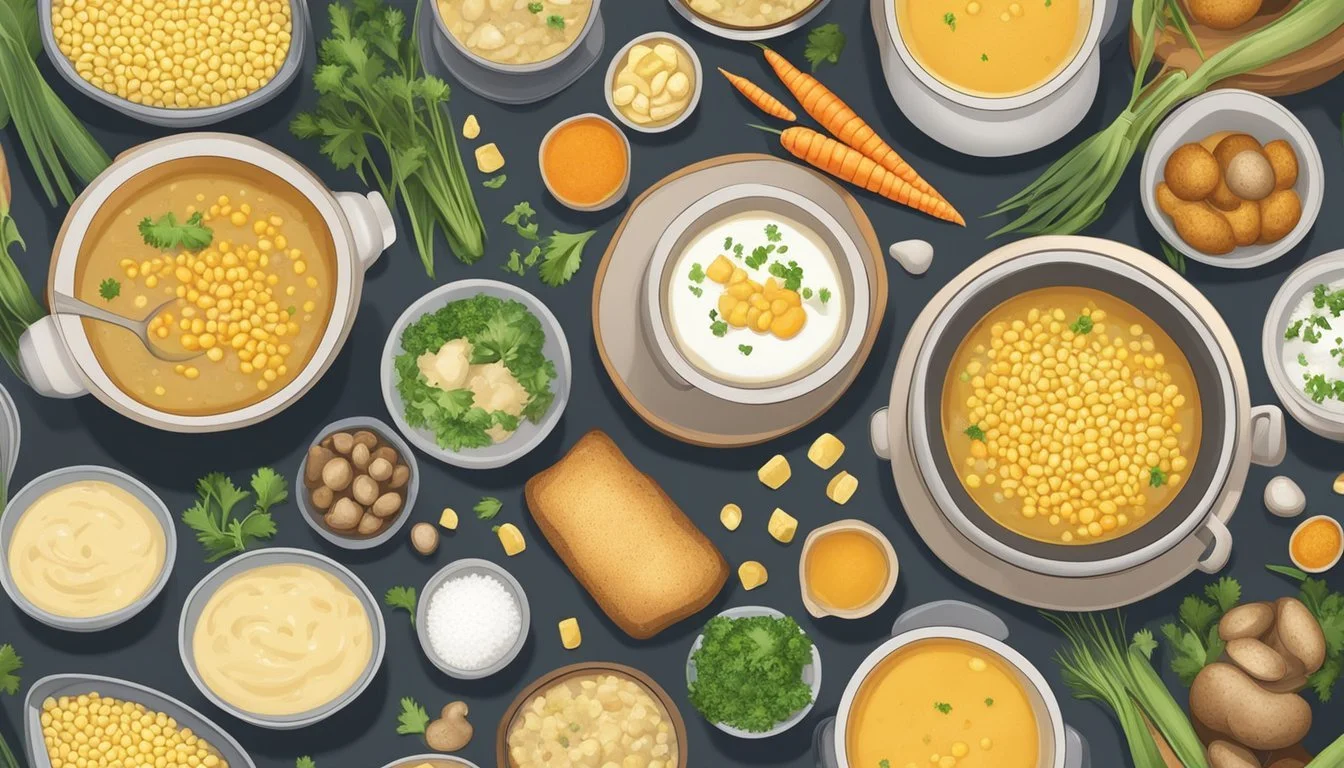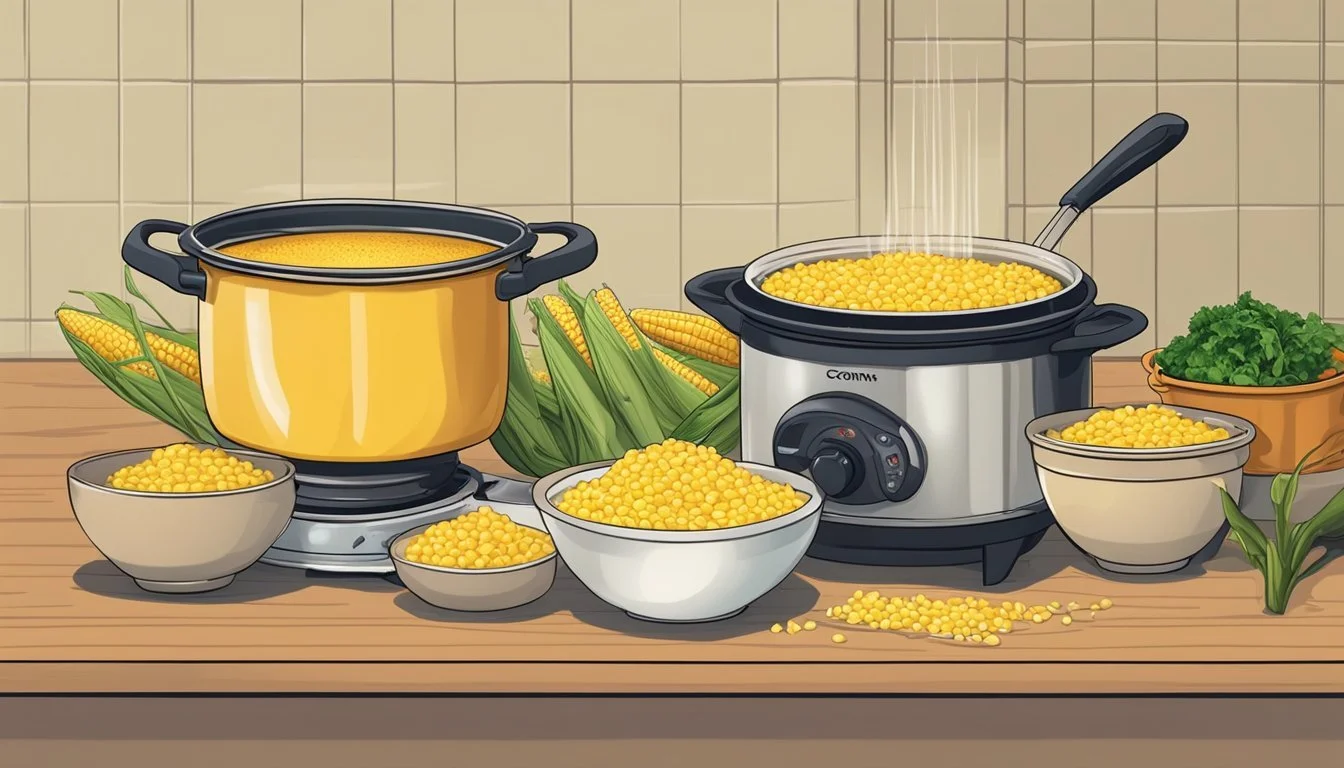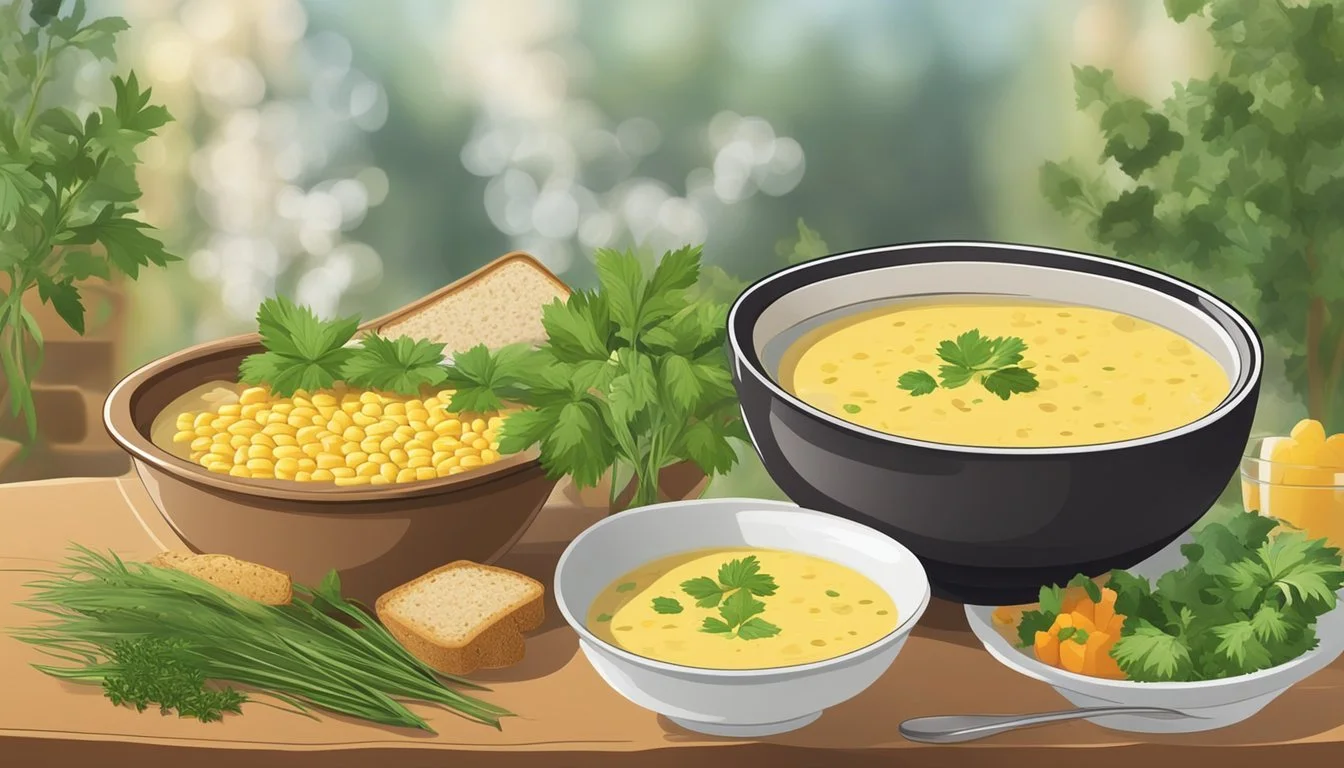Corn Soup Substitutes
Top Alternatives for a Delicious Twist
Corn soup is a comforting and popular dish known for its sweet and savory flavors, but not everyone can enjoy it due to dietary restrictions or personal preferences. Finding substitutes for corn in soup recipes can be a challenge, but there are many delicious alternatives that maintain the texture and flavor profile of the original dish. Among the best substitutes for corn in soups are sweet potatoes, red bell peppers, and chickpeas, which provide a similar sweet taste and satisfying bite.
When looking beyond corn, vegetables like carrots and celery are excellent choices for maintaining a hearty and healthy soup. Additionally, ingredients such as green lentils and quinoa can be utilized to add texture and nutritional value while seamlessly blending with other components. These substitutes not only ensure that the soup remains flavorful but also cater to different dietary needs.
A key benefit of using these alternatives is the versatility they bring to the table. Sweet potatoes can add a depth of flavor, red bell peppers provide a vibrant color and slight sweetness, while chickpeas offer a nutty taste and protein boost. This flexibility allows for creative adaptations of classic corn soup recipes, ensuring that anyone can enjoy a delicious and nourishing meal tailored to their preferences.
Understanding Corn Soup
Corn soup is a nutritious and flavorful dish that benefits greatly from the unique qualities of corn. This section explores the role of corn in soup and its nutritional value.
Role of Corn in Soup
Corn adds a distinct sweetness and texture to soups, making it an essential ingredient for many recipes. It offers a pleasant crunch when fresh or a smooth consistency when pureed. Fresh corn, frozen corn, and canned corn can all be used, depending on availability and convenience.
Fresh corn is often preferred for its vibrant flavor and texture, enhancing the overall freshness of the soup. Frozen corn retains most of its nutrients and is a convenient alternative. Canned corn, while less flavorful, is handy and can still contribute significantly to the dish.
Nutritional Value of Corn
Corn is valued not just for its taste but also for its nutritional benefits. It is high in carbohydrates, providing energy, and contains a moderate amount of protein.
Corn is also a good source of dietary fiber, which is important for digestive health. It contains vitamins such as B vitamins and vitamin C, and essential minerals like magnesium and potassium.
These nutrients make corn a healthy addition to soups, contributing to both flavor and nutritional value. Whether using fresh, frozen, or canned corn, its health benefits remain significant.
Common Corn Substitutes
Using substitutes for corn in recipes can enhance flavors and add nutritional variety. Key substitutes include various grains, vegetables, and legumes, each offering unique textures and taste profiles.
Grain-Based Substitutes
Quinoa is a popular grain substitute for corn due to its similar texture and flavor-absorbing properties. It works well in soups, salads, and casseroles.
Rice can also replace corn, especially in dishes like casseroles and stir-fries. For a heartier texture, consider using brown rice or wild rice variants.
Tapioca Starch and Potato Starch are excellent for thickening soups that typically use corn. They offer a neutral taste, ensuring they blend seamlessly with other ingredients.
Rice Flour can be used in similar applications, offering a smooth consistency.
Vegetable-Based Substitutes
Potatoes are versatile and can replicate the starchiness of corn in soups and chowders. They absorb flavors well and add a creamy texture when cooked.
Zucchini provides a fresh and slightly crisp alternative, especially in light soups and salads. It offers a subtle flavor that complements many dishes.
Red Bell Peppers are another excellent choice, offering sweetness and a slight crunch. They work well in both hot and cold dishes.
Legume-Based Substitutes
Chickpeas are a nutritious substitute, adding protein and fiber while maintaining a pleasant texture. They are particularly effective in soups and chilis.
Black Beans and Lentils are other valuable options. Black Beans bring earthiness and a sturdier texture, suitable for robust chilis. Lentils offer a softer consistency and are ideal for thick, hearty soups.
Green Lentils are especially good in salads, holding their shape well and adding a mild, peppery taste.
These substitutes ensure that the absence of corn doesn't compromise the dish's quality, making them excellent choices for a variety of recipes.
Sweetening Substitutes for Corn-Based Soups
For those looking to sweeten their corn-based soups without using traditional corn syrup, there are various options available. These alternatives range from syrups like maple or brown rice to natural sweeteners such as honey and agave nectar, each adding unique flavors and benefits.
Syrup Substitutes
Corn Syrup Substitute is a popular choice that maintains the viscosity and sweetness of traditional corn syrup without altering the flavor too drastically.
Maple Syrup provides a rich, woody sweetness that enhances the earthy tones of soups. It is especially effective in autumnal and winter recipes, imparting a warm, comforting flavor.
Simple Syrup, made from sugar and water, is an easy-to-make alternative that offers a straightforward sweetness without adding any complex flavors. It’s versatile and easily blends into most soups.
Brown Rice Syrup is another option, giving a mild sweetness and a slightly nutty flavor. It’s less sweet than corn syrup, so it works well in soups where a subtler sweetness is desired.
Natural Sweeteners
Honey is a versatile and widely available sweetener. Its floral notes and natural viscosity make it a good match for many corn-based soups, adding both sweetness and depth of flavor.
Agave Nectar and Agave Syrup are both derived from the agave plant and offer a light, honey-like sweetness. They dissolve easily in soups and are a great choice for those seeking a vegan-friendly option.
Using these substitutes can maintain the desired sweetness level in corn-based soups while also introducing new flavors and potential health benefits. Each sweetener has its own characteristics, so it's worthwhile to experiment and find the best match for specific recipes.
Substitutes for Cornmeal in Soup-Related Recipes
When preparing soups, cornmeal adds a unique texture and flavor. However, several other ingredients can serve as excellent substitutes, each offering distinct characteristics suited for different dietary needs and culinary preferences.
Grain and Nut Flour Substitutes
Almond Flour
Almond flour brings a nutty flavor and subtle sweetness to soups. It can thicken broths while also being gluten-free. Due to its finer texture, it seamlessly blends into the soup without altering its consistency drastically. Use almond flour in a 1:1 ratio as a substitute for cornmeal.
Ground Oats
Ground oats provide a hearty texture and can help thicken soups. They have a mild flavor, ensuring they do not overpower the primary taste of the soup. To use ground oats, process them in a blender until fine and use in equal proportions to cornmeal.
Semolina, made from durum wheat, is another viable option. It creates a slightly grainier texture, adding a distinct mouthfeel to soups. Semolina absorbs more liquid, so adjust accordingly when using it. Replace cornmeal with semolina by measuring one cup of semolina per one cup of cornmeal.
Non-Grain Alternatives
Masa Harina
Masa harina, a treated corn product, brings a mild corn flavor and a smooth texture to soups. Unlike cornmeal, it's pre-cooked, making it quicker to integrate into the dish. Use masa harina in a 1:1 substitution for cornmeal.
Ground Flaxseeds
Ground flaxseeds are perfect for those seeking a high-fiber and gluten-free option. They have a slightly nutty flavor and thicken soups effectively. For best results, mix ground flaxseeds with water to create a slurry before adding it to the soup. One tablespoon of ground flaxseeds mixed with three tablespoons of water can replace about ¼ cup of cornmeal.
Innovative Add-Ins to Enhance Corn Soup
Incorporating additional ingredients can transform a basic corn soup into a gourmet delight. This section explores various proteins, vegetables, and herbs that can elevate the flavor and texture of the soup.
Protein Add-Ins
Meat: Adding cooked, shredded chicken or ham can introduce a savory depth to the soup. These meats complement the sweetness of the corn and provide a substantial protein boost.
Tofu: For a vegetarian option, tofu is an excellent choice. Cubed or crumbled tofu absorbs the flavors of the soup well while offering a smooth texture and protein.
Chickpeas & Black Beans: Chickpeas and black beans add not only protein but also a nutty flavor and firm texture. These legumes blend seamlessly with corn, offering additional nutrients and making the soup more filling.
Vegetable Add-Ins
Carrots & Celery: Finely diced carrots and celery add a satisfying crunch and an extra layer of flavor. Carrots contribute sweetness, while celery provides a subtle savory note, enhancing the overall taste.
Red Bell Peppers: Red bell peppers introduce a hint of spice and vibrant color. They also add a crisp texture that contrasts nicely with the creamy corn soup.
Potatoes: Cubed potatoes can make corn soup heartier. They soak up the broth well and provide a comforting, starchy base that complements the corn.
Herb and Spice Add-Ins
Rosemary: A small amount of fresh or dried rosemary can add a woodsy, aromatic undertone. Its robust flavor pairs well with the sweet notes of the corn.
Sage: Sage provides an earthy, slightly peppery taste that enriches the soup's profile. It's particularly good in richer, creamier versions of corn soup.
Salt & Pepper + Other Herbs: Basic seasonings like salt and pepper are essential, but fresh herbs like parsley or thyme can also enhance the dish’s freshness. A dash of hot sauce or red pepper flakes can add a bit of heat for those who prefer a spicier soup.
Corn Soup Serving Suggestions
Corn soup can be a versatile dish suitable for various meals. Pairing it correctly enhances its flavors and offers a balanced dining experience.
Salad Pairings
A fresh green salad can complement the rich, creamy texture of corn soup. Mixed greens with a light vinaigrette work well, adding a crisp contrast. For more substance, consider a Greek salad with cucumber, tomatoes, olives, and feta cheese, which offers refreshing flavors and a slight tanginess.
Coleslaw can also be a great pairing, providing a nice crunch and a bit of sweetness. Quinoa salad is another good option, bringing in some protein and complexity to the meal. For those seeking a more robust option, a Caesar salad with croutons and Parmesan can be ideal.
Side Dish Recommendations
A variety of side dishes can accompany corn soup. French fries or sweet potato fries offer a satisfying crisp texture that contrasts well with the soup. For a healthier option, steamed vegetables like carrots, broccoli, or green beans can add color and nutrients.
Rice pilaf can be another excellent choice, providing a hearty, flavorful base. Grilled vegetables such as zucchini, bell peppers, and eggplant add a smoky flavor. Consider garlic bread or buttered rolls for those who enjoy dipping bread into their soup for added comfort.
Tips for Storing and Reheating Corn Soup
Proper storage and reheating techniques can ensure your corn soup maintains its flavor and texture. Follow these guidelines to store and reheat your corn soup efficiently.
Refrigeration and Freezing Practices
To store corn soup in the refrigerator, let it cool completely before transferring it to an airtight container. Seal the container properly to prevent refrigerator odors from affecting the soup's taste. Store it in the refrigerator and consume within 3-4 days.
Freezing corn soup is possible, but not ideal if it contains cream. Cream-based soups tend to separate when frozen. If you decide to freeze it, use freezer-safe bags or containers, leaving some space for expansion. Label your containers with the date to track freshness. Thaw frozen soup in the refrigerator overnight before reheating.
Reheating Techniques
Reheating corn soup can be done on the stovetop or in a microwave. For stovetop reheating, place the soup in a pot and warm it over medium heat. Stir occasionally to prevent sticking and add a little water or stock if the soup appears too thick. Heat until it reaches the desired temperature.
When using a microwave, transfer the soup to a microwave-safe bowl. Cover it with a vented lid or microwave-safe plastic wrap. Heat in short intervals, stirring in between to ensure the soup heats evenly. Adjust the time based on the microwave’s power.
For best results, always reheat only the amount of soup you plan to consume to maintain its quality. Avoid reheating multiple times, as this can degrade the flavor and texture.





